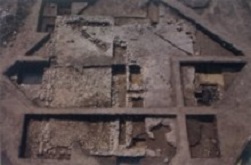
The main building of the Roman villa at Zillingtal with post-antique disturbances (Anton Distelberger, Vienna)

The plan of the main building of the Roman villa at Zillingtal, post-antique disturbances shown in blue, cyan, green and orange (plan: Ulrike Fornwagner, Nicole Pieper, Ingrid Adenstedt, Vienna)
Archaeology of the Avar Khaganate, with a special emphasis on the settlement and cemetery of Zillingtal (Burgenland, Austria, 7th–8th centuries AD)
Hajnalka Herold
The settlement of Zillingtal is among the first archaeologically investigated settlements in Austria that can be connected to the early medieval political unit known as the Avar Khaganate. The results from the analysis of the Zillingtal settlement and their comparison to other sites of this polity, mostly situated today in neighbouring countries of Austria, brought new insights into early medieval settlement activity in this region of Europe, especially concerning the (re)use of Roman ruins in the early Middle Ages. Archaeometric analysis and experimental archaeology aided in reconstructing patterns of ceramic production and use in the Avar period. Traditions of depositing grave goods were examined in the cemetery of Zillingtal in relation to the age and gender of the buried persons. This study was based on the results of the archaeological and archaeometric analysis of the 469 ceramic vessels found in the 586 modern excavated graves at Zillingtal and on the physical anthropological data of the burials. The investigations revealed gender-specific patterns in selecting the culturally accepted vessels for deposition in the grave as well as changes in these traditions through time.
Herold, H. 2010, Zillingtal, Burgenland – Die awarenzeitliche Siedlung und die Keramikfunde des Gräberfeldes (Zillingtal, Burgenland: The Avar Period Settlement and the Ceramic Finds of the Cemetery – in German), Monographien des Römisch Germanischen Zentralmuseums, Volume 80:1 (378 pages, 89 figures, 3 plans) & Volume 80:2 (220 plates), Mainz: Roman-Germanic Central Museum (RGZM) Press.
These two volumes have been subject to peer-review in the course of the application for printing costs at the Austrian Science Fund (application no. D3996 & D3997).
Review: Christie, N. 2012, Medieval Archaeology 56, 369–370.
